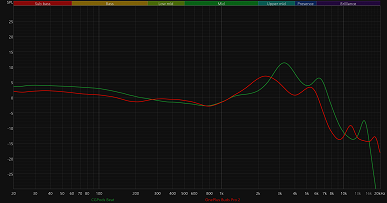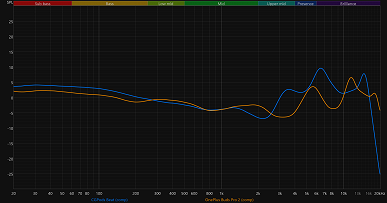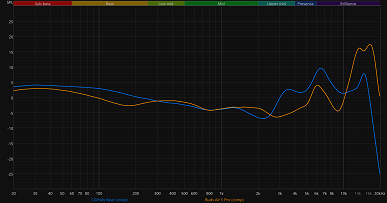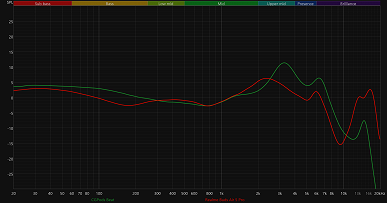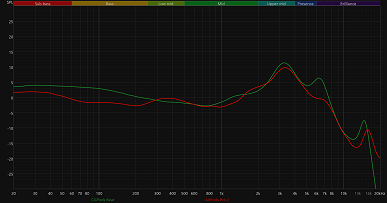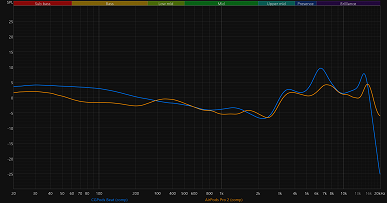The fact that CaseGuru headphones are produced in China and their quality have already been discussed quite widely: all the scandals, intrigues and investigations are in the past, and the situation is clear to everyone. As mentioned in one of the previous reviews, these headphones are just «very average» but sell for a price comparable to good ones.
Previously, CaseGuru offered relatively affordable headphones, but now they have released a model in the high price segment, where competition is very high. The company describes the new product as “the flagship model — the best thing we’ve ever done,” maintaining a tradition of bold statements and high assessments of its own achievements.

For the first time, the manufacturer indicates in detail many characteristics that are usually familiar to other headphones — from the size of the speakers to the supported codecs, on which special emphasis is placed. The stated technical characteristics look very encouraging. In general, curiosity arose — let's see what CaseGuru considers its best creation.
Specifications
| Speakers | ∅10 mm |
|---|---|
| Declared frequency range | 20 Hz — 20 kHz |
| Connection | Bluetooth 5.3 |
| Codec support | SBC, AAC, aptX Adaptive, LC3 |
| Multipoint | There is |
| Control | sensory |
| Active Noise Cancellation | No |
| Headphone battery capacity | 35 mAh |
| Case battery capacity | 480 mAh |
| Battery life | up to 6 hours |
| Autonomy including charging from the case | up to 70 hours |
| Charging connector | USB Type-C |
| Fast charging | not declared |
| Water protection | not declared |
| Case dimensions | 57×45×26 mm |
| Earphone dimensions | 28×26×20 mm |
| Weight of one earphone | 4 g |
| Case weight | 33 g |
Packaging and equipment
The packaging design remains iconic: a white box with an image of the device and brief technical specifications, as well as the inscription “created in Tyumen.” This approach, as we have already discussed, is often used by marketers of large equipment manufacturers who indicate “designed in...” and “made in China.” This way, they show that the device is designed in one place and manufactured in another, which is a fair and transparent approach. In this case, the authors of the description chose a unique linguistic device by combining both aspects under the word “created”, which can refer to both development and production.
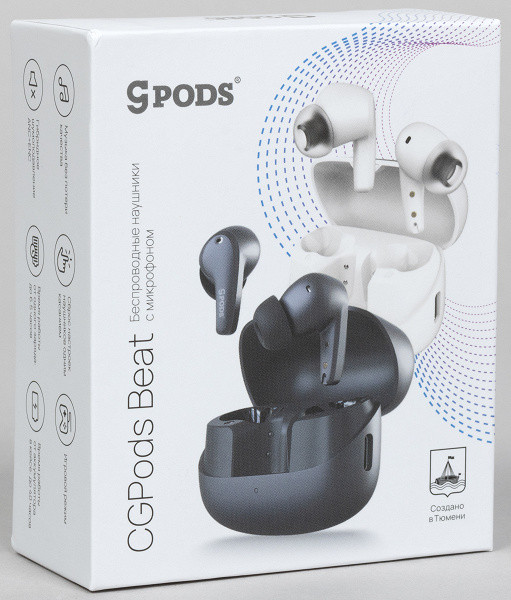
The delivery package includes headphones in a case, two additional pairs of silicone tips of different sizes, a booklet with information about the company (which we have already seen), an instruction manual, a catalog of brand products, as well as a USB-A — USB-C charging cable 20 cm long .
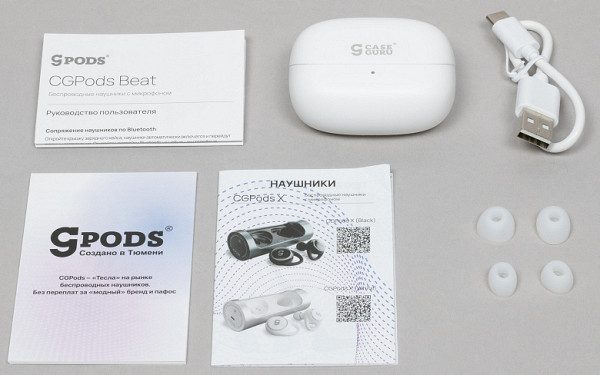
The attachments are made of pleasant-to-touch silicone at a quite decent level of quality — like most other headsets, including budget ones.
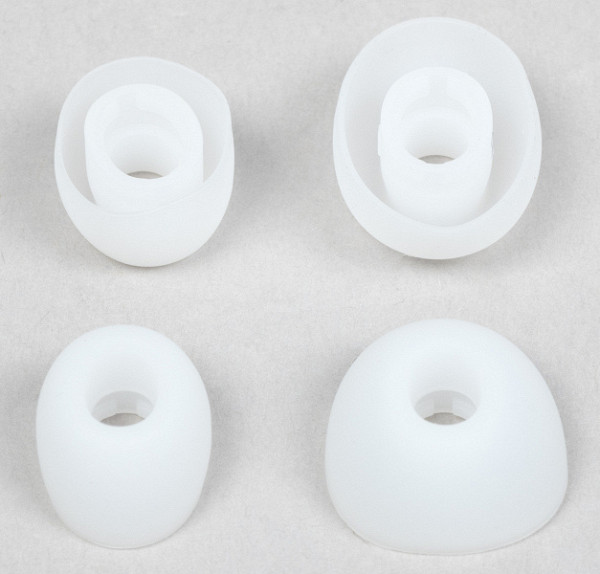
Design and construction
We chose the CGPods Beat headphones in white as the more classic and versatile option of the two available. The case is compact, its dimensions are 57x45x26 mm. The front and back panels of the case are flat, making it ideal for carrying even in a small trouser pocket. On the front panel there is a large manufacturer's logo, as well as a small LED indicator that displays the device status and charge level.
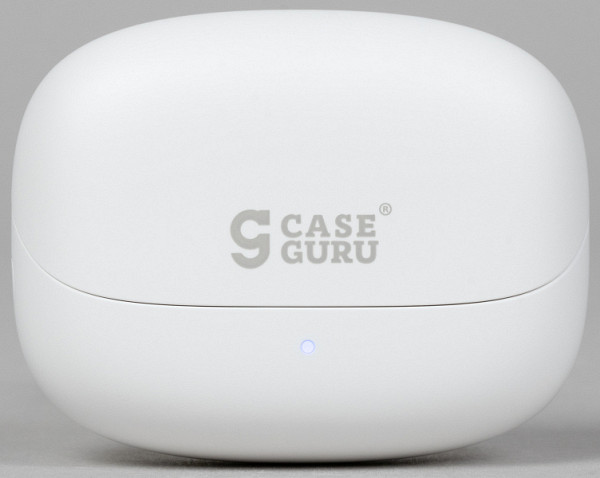
On the left side panel of the case there is a button to start Bluetooth pairing. It is placed flush with the surface of the case, which prevents accidental pressing.

On the right side of the case there is a USB Type C port for charging. The case is assembled very well — no gaps or creaks were noted during the entire testing period.
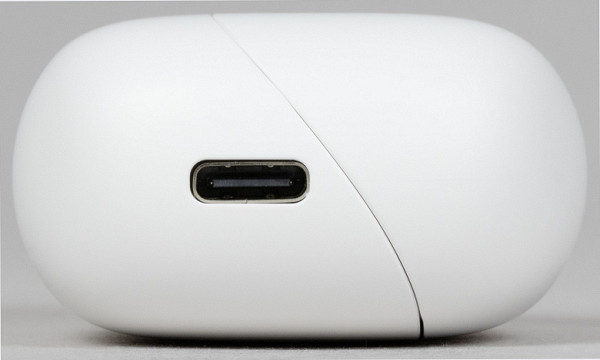
The case is made of matte plastic, which is not prone to staining from touch. There is a hinge on the back panel that allows the lid to open.
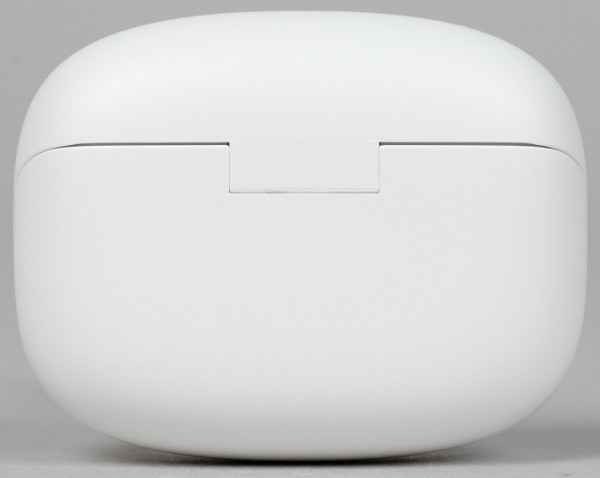
The lid opens gently and with a pleasant effort; you can open the case with a finger of the same hand that holds it. There is a closer and it operates in both directions approximately halfway through.

The headphones inside the case are not fixed in special holes for them, but use magnetic mounts to keep them in place. This system does an excellent job — the headphones stay securely in the open case even with intense movements or shocks.

They are extremely easy to remove from the case — just grab them with your fingers and pull them slightly towards you.
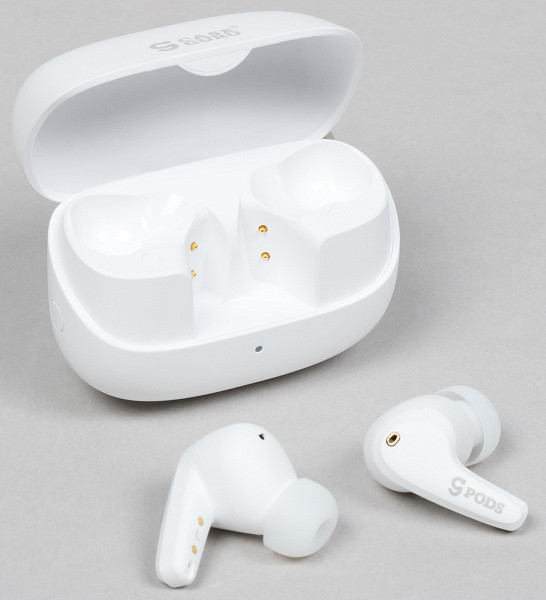
Inside the case, spring contacts for charging are visible, which can be easily cleaned if necessary. Recesses for the rounded part of the headphones provide a more secure hold.
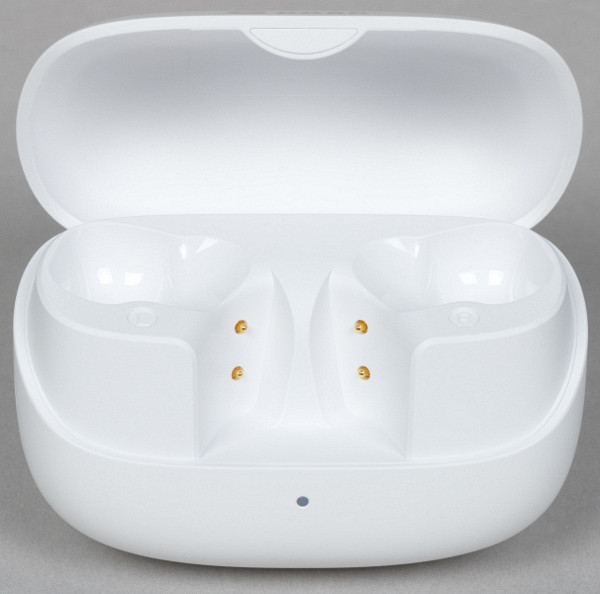
The headphones themselves are made in the usual “with a stick” format. At the same time, the shape of the elongated part was chosen to be unusual — with pronounced edges and flattened front and rear surfaces.
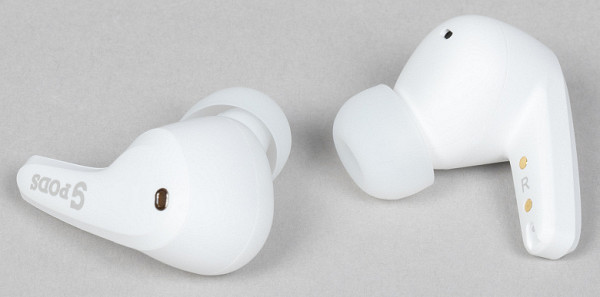
The ribs on the elongated part are clearly visible, but do not in any way affect the comfort of wearing the headset, performing primarily a decorative function.
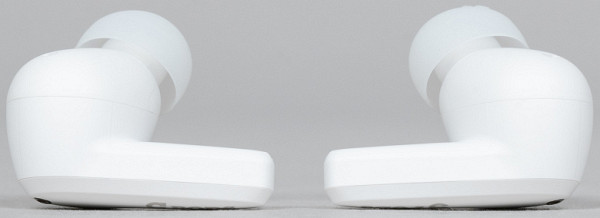
The rounded part is large; there are protrusions on its inner surface for better support on the cup of the auricle.
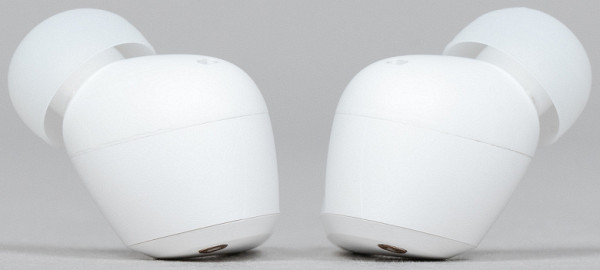
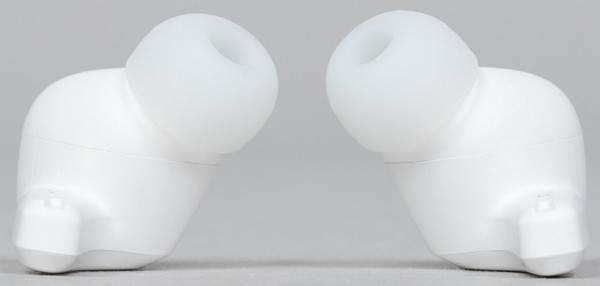
The sound guide exits the body at an angle and is of medium length, which means it will not plunge too deeply into the ear canal, causing discomfort.
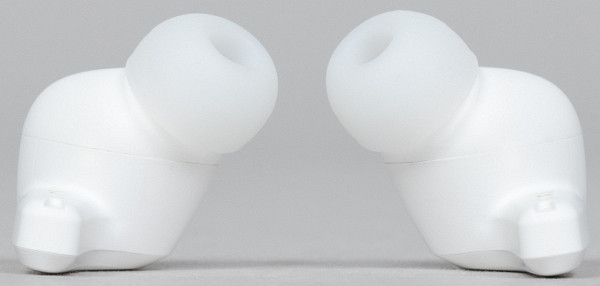
A large logo is applied to the outer part of the “legs” — the manufacturer made sure that others would have no doubt about which headphones are in the user’s ears.

A large logo is applied to the outer part of the “legs” — the manufacturer made sure that others would have no doubt about which headphones are in the user’s ears.

On the inside of the “legs” there are markings for the right and left headphones, and there we also see contacts for charging.

The hole for the microphones is located on the inside of the “sticks” and placed in a special recess, potentially protecting the microphones from “blowing out” in windy weather and during active movement.

On the inner surface of the round part there is another hole for noise reduction microphones, covered from the inside with a metal mesh.
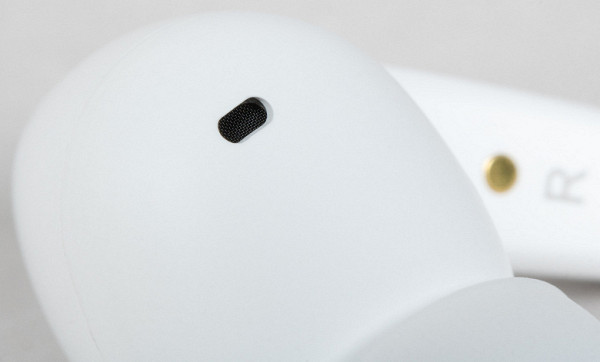
The silicone tips are securely fixed due to a large protrusion at the end of the sound guide; they are easy to remove and install back if necessary. On the side of the sound guide there is a compensation hole designed to relieve excess pressure when the speaker is operating.
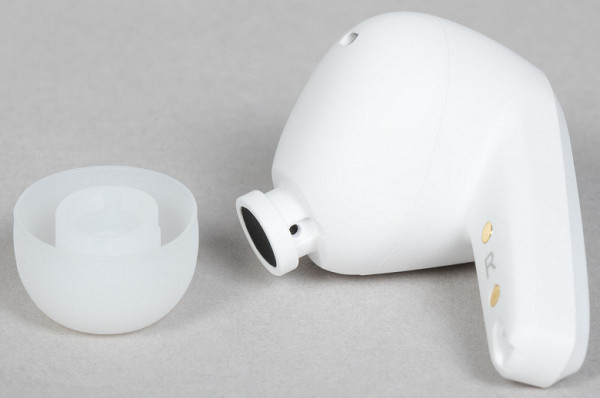
The hole at the end of the sound guide is covered with a mesh that prevents dirt from getting inside. The mesh is partially pressed inward, but this should not significantly complicate its cleaning, if necessary.
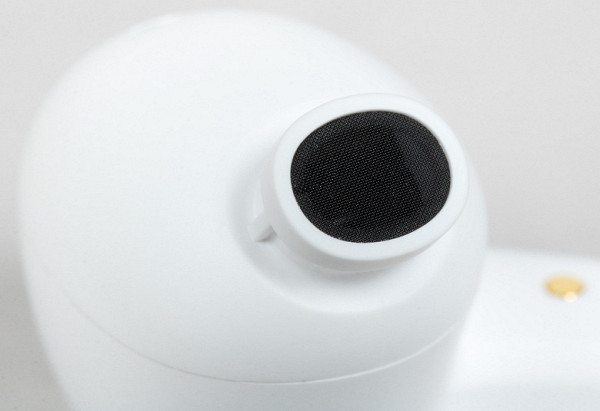
Connection and setup
The headphones are connected in the standard way through the smartphone menu. After being removed from the case, they automatically turn on and for some time try to connect with already familiar devices. If the connection is not established, pairing mode is activated. You can force start this process using the button on the case. It also allows you to connect headphones to two sound sources at once — the multipoint of CaseGuru CGPods is implemented and functions correctly, which was tested when simultaneously connected to an Android smartphone and a PC running Windows 11. Also, using the Bluetooth Tweaker utility, a complete list of supported codecs and modes was obtained their work.

The headphones contain all the declared codecs: SBC, AAC and aptX Adaptive, which stands out. For the SBC codec, the maximum Bitpool setting is set to 53, which is the recommended High Quality profile, which uses a value of 51 for optimal performance. AAC bitrate is capped at a top level of 264 Kbps, versus the usual 256 Kbps on most devices. The descriptions also mention support for the new LC3 codec, but its presence could not be confirmed by the utility used.
The connection remained stable, with no audio stuttering noted throughout the entire test. However, when playing a video or playing, sometimes “out of sync” occurred, which was successfully eliminated by activating the “game mode” or switching to using the SBC codec.
Management
The CaseGuru CGPods come with a touch-sensitive external control panel, which is a convenient feature. However, the lack of software for fine-tuning can be seen as a disadvantage at this price point.
Here are the main control functions:
- Play and answer a call — short press on any of the headphones.
- End or reject a call — long press on any of the headphones.
- Switch tracks — double click on the left or right earphone.
- Activate the voice assistant — triple click on the left earphone.
- Turn on game mode — four taps on the left earphone.
- Switching noise reduction modes — triple click on the right earphone.
- Changing the volume — double click on the right or left earphone.
Although the controls seem logical, difficulties arise in practice. A single press can easily pause playback accidentally when adjusting the headphones. Double tapping requires precision to avoid mistakes. Multiple clicks are also not always recognized the first time, even after training. Activating noise canceling requires pressing three times, and game mode requires pressing four times, which can be inconvenient.
During testing, problems arose such as the headphones did not turn on after being removed from the case, which required a long touch on the touch zone. Sometimes the headphones did not turn off after being placed in the case, which required turning it off through the smartphone menu in order to receive a call through the built-in speakers and microphone. This sometimes created inconvenience in everyday use. They also found that when experimenting with frost resistance, the headphones became less responsive to controls.
Thus, although the basic controls are convenient, some aspects of the headphones' operation may be unpredictable and require the user's attention.
Exploitation
The round part of the CGPods Beat headphones is quite large, which provides good support for the ear cup thanks to the protrusions on their inner side. This ensures a very tight and secure fit — the headphones do not fall out even with active movements, which makes them suitable for sports. They also provide a good level of passive sound insulation, which improves acoustic comfort.
However, this landing also has disadvantages. Those with small ears may find the headphones uncomfortable, while people with larger ears may only enjoy comfort for an hour to an hour and a half. After this, pressure on the inside of the cup and the antihelix begins to be felt more clearly. However, this is a matter of individual preference — there may be an ear somewhere on the planet that is ideal for using the CaseGuru CGPods Beat headphones.
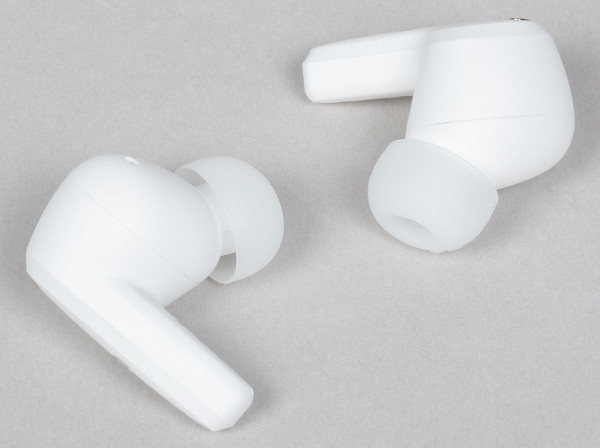
Noise cancellation in CaseGuru CGPods Beat headphones is implemented very simply — only one mode and the “sound transparency” function. Despite this simplicity, the system works surprisingly well and delivers results comparable to those from well-known brands. The main focus is on the low-frequency range, where the system effectively suppresses noise from crowds, motors and other low-frequency noise sources. If it were not for the activation problems mentioned earlier, using this system would be quite comfortable and effective.
Microphones for voice communication
To evaluate the performance of microphones for voice communication in CaseGuru CGPods Beat headphones, we use a specially prepared room and a monitor speaker system that reproduces a sweep tone. The initial frequency response of speakers is usually not uniform, so we first obtain its graph using a calibrated measuring microphone. This data is then used to create a correction profile that compensates for room acoustics. The signal is then recorded using the microphone under test, located in the same location as the measurement microphone previously. The resulting graph is adjusted using the created profile, which allows us to obtain the final frequency response of the microphone under test.

The voice of an adult man has a fundamental frequency from 85 to 155 Hz, in women — from 165 to 255 Hz. However, speech transmission typically uses frequencies between 300 and 3400 Hz, known as “voice” frequencies, as the formants important for speech intelligibility are found in this range. Frequencies below this range are typically suppressed not only due to transmission channel limitations, but also due to the presence of unwanted sounds such as engine noise and low-frequency crowd noise.
Excessively suppressing the edges of the range, emphasizing the midrange and emphasizing key frequencies responsible for speech intelligibility can result in a sound that sounds unnatural, with a so-called “telephone effect”. The CGPods Beat microphones also tend to clip slightly, even with relatively smooth speech. This shows up in recordings as sound distortion due to microphone overload.
The result, to put it mildly, is so-so — the noise is audible, and the voice began to sound even more unpleasant.
Autonomy and charging
The battery life of CaseGuru CGPods Beat declared by the manufacturer is up to 6 hours with active noise cancellation disabled. This figure is typical for modern, good quality fully wireless headphones. We will now verify this data with our own tests.
For most users, a safe sound pressure level when listening to music is considered to be 75 dB, but many prefer to listen to music at a level of 90-100 dB. We test by broadcasting white noise through headphones and recording the sound pressure level at around 95 dB. After the playback starts, we start recording the signal from the measuring stand to determine the actual operating time of each headphone.
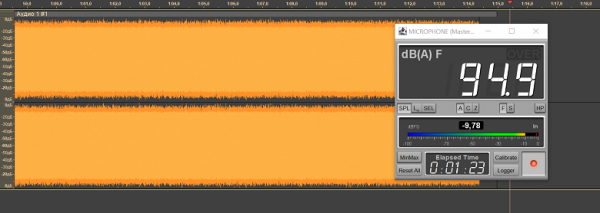
The headphones discharge unevenly — with a difference of up to 20 minutes. Few users prefer to use headsets in mono mode; most often, turning off one of them is a signal to place both in the charging case. Therefore, when assessing autonomy, we focus on the operating time of the earphone, which discharges faster.
| Tests | Left earphone | Right earphone | |
|---|---|---|---|
| Noise canceling is off | Test 1 | 6 hours 8 minutes | 5 hours 42 minutes |
| Test 2 | 6 hours 12 minutes | 5 hours 47 minutes | |
| Total | 6 hours 10 minutes | 5 hours 45 minutes | |
| Noise cancellation enabled | Test 1 | 3 hours 34 minutes | 3 hours 21 minutes |
| Test 2 | 3 hours 30 minutes | 3 hours 14 minutes | |
| Total | 3 hours 32 minutes | 3 hours 18 minutes |
The results are close to the stated ones, which is excellent — for a trip to the office and training in the gym, for example, one charge of the headphones should be enough. Fast charging is not supported, which is confirmed by practice — after 10 minutes in the case, the headset worked for just under half an hour.
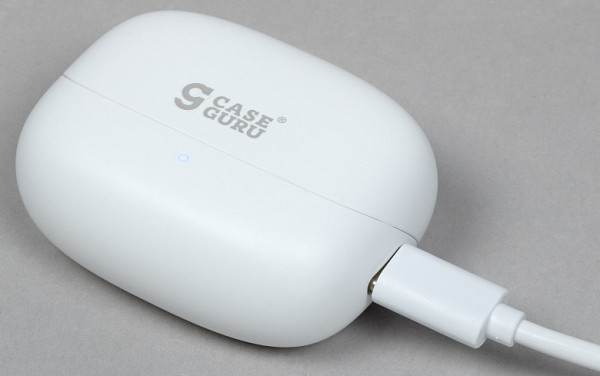
The case can fully charge the headphones up to 6 times, so taking into account the possibility of recharging from it, we have at least 20 hours of operation — great, you won’t have to charge the device so often. It takes 1.5-2 hours to fully charge the headphones, so it is important to remember that they can be placed in the charging case. The case itself charges in a couple of hours — this is not a record figure, but quite acceptable.
Sound and frequency response measurements
As for the sound of CaseGuru CGPods Beat, they are far from the sound of the “flagship in the world of sound,” which is quite expected. However, there was hope that the sound would be acceptable. However, this is not so: the bass sounds booming and too accentuated, capturing all the attention and interfering with the perception of the midrange, which is already not very detailed. In the high-frequency range there are also problems with unpleasant ringing and “sand”. In general, it can be worse, but more is expected from headphones at this price.
Traditionally, we would like to draw the attention of readers to the fact that all frequency response graphs are used solely as an illustration to demonstrate the main sound features of the headphones being tested. You should not draw final conclusions about the quality of a particular model from them. The actual perception of each listener depends on many factors, ranging from the structure of the auricle to the influence of pressure on the ear pads, which significantly affects the transmission of low frequencies.
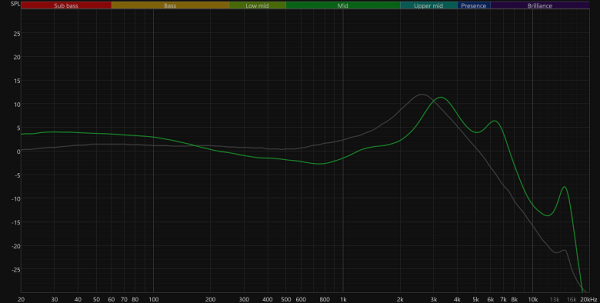
The frequency response graph is presented against the background of the IDF (IEM Diffuse Field) curve provided by the manufacturer of the stand used. It is designed to compensate for resonant effects in the simulated ear canal and take into account the characteristics of the equipment, creating a “sound profile” that most accurately reflects the listener’s perception of the sound of the headphones. The IDF can be thought of as a device-specific analogy to the “Harman Curve” developed by the Harman International team led by Dr. Sean Olive. We adjust the resulting frequency response graph according to the IDF curve to more accurately reflect the sound characteristics of the headphones.

The frequency response graph is presented against the background of the IDF (IEM Diffuse Field) curve provided by the manufacturer of the stand used. It is designed to compensate for resonant effects in the simulated ear canal and take into account the characteristics of the equipment, creating a “sound profile” that most accurately reflects the listener’s perception of the sound of the headphones. The IDF can be thought of as a device-specific analogy to the “Harman Curve” developed by the Harman International team led by Dr. Sean Olive. We adjust the resulting frequency response graph according to the IDF curve to more accurately reflect the sound characteristics of the headphones.
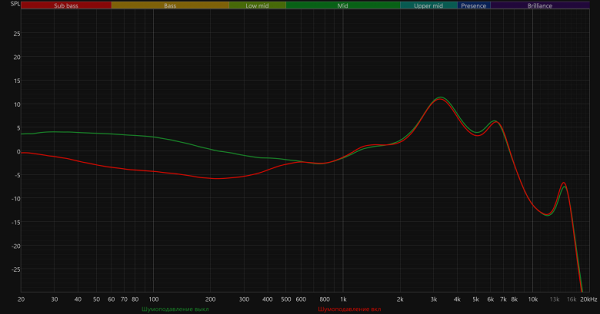
Comparison with other models
As noted at the beginning of the review, there are many high-quality headphones available for about 10 thousand rubles. Let's look at a few examples and discuss their main advantages compared to CaseGuru CGPods Beat. Let's start with Huawei FreeBuds Pro 2, developed with the participation of French specialists from Devialet. These completely wireless headphones are known for their smooth and monitor-like sound.
In addition, they have excellent microphones, high-quality software for control and configuration, and a full-fledged equalizer. Despite the release of newer versions, Huawei FreeBuds Pro 2 can still be found on sale for the indicated 10 thousand rubles. As an illustration, we will attach frequency response graphs to each comparison: on the left — without any correction, on the right — with correction in accordance with the IDF curve.
Another great pair of headphones that are around the same price range are the OnePlus Buds Pro 2R. They are aimed at bass lovers — low frequencies are highlighted, but the sound remains dynamic. The Danish company Dynaudio participated in the development, and one of the sound profiles was developed by the famous German film composer Hans Zimmer, winner of numerous awards, including two Oscars, three Golden Globes and four Grammys. Although it is not entirely correct to compare him with “Tumen’s Elon Musk,” he certainly understands sound.
Well, the headphones also offer a number of other interesting features — from dual drivers to setting the “golden profile” of sound. Sound customization options are supported by good software, there are also high-quality microphones for voice calls, Google Fast Pair support, customizable active noise reduction and other features. The controls are comfortable, the fit is comfortable, and a stable connection to the sound source is what sets these headphones apart from their competitors.
Realme Buds Air 5 Pro are available for a noticeably lower price — about 6 thousand rubles at the time of testing. At the same time, they offer water resistance, support for the LDAC codec, and fairly good battery life. There's also the ability to create personalized sound profiles, as well as 'spatial audio', making them an interesting choice without paying extra. The sound on these headphones is also pleasant and meets high standards for wireless headsets.
Realme Buds Air 5 Pro are available for a noticeably lower price — about 6 thousand rubles at the time of testing. At the same time, they offer water resistance, support for the LDAC codec, and fairly good battery life. There's also the ability to create personalized sound profiles, as well as 'spatial audio', making them an interesting choice without paying extra. The sound on these headphones is also pleasant and meets high standards for wireless headsets.
Results
The new CGPods model has increased significantly in price, expanding its functionality: a good noise reduction, support for advanced codecs and multipoint have been added. The build quality is impeccable, the design is nice, the case is comfortable… This may be the best thing CaseGuru has ever offered. However, as always, the question is whether this “very average” headset is worth its high price.
Past CGPods often didn't justify their price, but were generally acceptable. In the case of the CGPods Beat, however, there are at least three serious shortcomings that prevent them from being considered even «overpriced middling»: the sound is subpar, the controls are awkward, and the microphone for voice calls is poor. Without taking into account such important functions as software, water protection, equalizer and other “tricks” that are present in most competitors in this price segment, the verdict becomes clear and categorical. Good headphones for that kind of money can be found in large quantities, so when purchasing, you should pay attention to alternatives.



